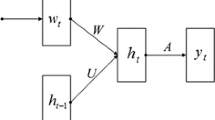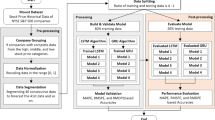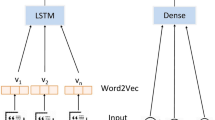Abstract
One of the most significant challenges in stock market forecasting is that the majority of stock price analysis and prediction models based on quantitative data rely on stock trends as their primary metric. These metrics may exhibit good intra-day performance, but have scalability issues when applied to inter-day trading, limiting their accuracy for real-time prediction. The systems that use news and social media data have limited correlation capabilities due to inefficiencies in trend analysis. Fusion of these data sources is expected to improve stock market prediction accuracy. This paper proposes a novel augmented analysis model for fusing spatial and temporal stock trends with global–local market movements via incremental learning. The novel multiparametric augmentation model is based on hybrid of machine and deep neural architectures like support vector machine, recurrent neural network and convolutional neural network. The model integrated five heterogeneous data sources. The model initially identifies global news trends, and correlates them with temporal and spatial stock values. This correlation is further improved by evaluation of local news trends with respect to stock specific geographies and events. This assists in identification of spatial and temporal factors that drive a particular stock’s value, and improve the efficiency of trend analysis. The estimated trend is combined with an incremental learning model, that estimates intra-day stock values with respect to incremental value variance. The proposed model has been tested on numerous local and international stocks from Ten different sectors namely IT, healthcare, energy, communication services, financial, industrial, real estate, consumer discretionary, consumer staples and others over a period of 300 days. The highest accuracy of 95% is observed in terms of stock trend prediction and 99% for stock value close price prediction, with average accuracy of 97.36%.



Similar content being viewed by others
Change history
29 December 2023
A Correction to this paper has been published: https://doi.org/10.1007/s10614-023-10521-0
References
Aithal, P. K., Acharya, D., & Geetha, M. (2019). Identifying significant macroeconomic indicators for Indian stock markets. IEEE Access, 7, 143829–143840. https://doi.org/10.1109/ACCESS.2019.2945603
Aldhyani, T., & Alzahrani, A. (2022). Framework for predicting and modeling stock market prices based on deep learning algorithms. MDPI, 11, 1–19. https://doi.org/10.3390/electronics11193149
Alsubaie, Y., Hindi, K. E., & Alsalman, H. (2019). Cost-sensitive prediction of stock price direction: Selection of technical indicators. IEEE Access. https://doi.org/10.1109/ACCESS.2019.2945907
Arvind, S., & Pradeep, S. (2022). Uncertainty optimization based feature selection model for stock marketing. Computational Economics. https://doi.org/10.1007/s10614-022-10344-5
Bansal, M., Goyal, A., & Choudhary, A. (2022). Stock market prediction with high accuracy using machine learning techniques. In 4th international conference on innovative data communication technologies and application (Vol. 215, pp. 247–265). Elsevier. https://doi.org/10.1016/j.procs.2022.12.028
Bi, J. (2022). Stock market prediction based on financial news text mining and investor sentiment recognition. Hindawi. https://doi.org/10.1155/2022/2427389
Bouktif, S., Fiaz, A., & Awad, M. (2020). Augmented textual features-based stock market prediction. IEEE Access, 8, 40269–40282. https://doi.org/10.1109/ACCESS.2020.2976725
Bousoño-Calzón, C., Bustarviejo-Muñoz, J., Aceituno-Aceituno, P., & Escudero-Garzás, J. J. (2019). On the economic significance of stock market prediction and the no free lunch theorem. IEEE Access, 7, 75177–75188. https://doi.org/10.1109/ACCESS.2019.2921092
Bousoño-Calzón, C., Molina-Bulla, H., Escudero-Garzás, J. J., & Herrera-Gálvez, F. J. (2018). Expert selection in prediction markets with homological invariants. IEEE Access, 6, 32226–32239. https://doi.org/10.1109/ACCESS.2018.2846878
Cao, B., Zhao, J., Lv, Z., Gu, Y., Yang, P., & Halgamuge, S. K. (2020). Multiobjective evolution of fuzzy rough neural network via distributed parallelism for stock prediction. IEEE Transactions on Fuzzy Systems, 28(5), 939–952. https://doi.org/10.1109/TFUZZ.2020.2972207
Chacón, H. D., Kesici, E., & Najafirad, P. (2020). Improving financial time series prediction accuracy using ensemble empirical mode decomposition and recurrent neural networks. IEEE Access, 8, 117133–117145. https://doi.org/10.1109/ACCESS.2020.2996981
Chandola, D., Mehta, A., Singh, S., Tikkiwal, V. A., & Agrawal, H. (2022). Forecasting directional movement of stock prices using deep learning. Annals of Data Science. https://doi.org/10.1007/s40745-022-00432-6
Chen, L., Qiao, Z., Wang, M., Wang, C., Du, R., & Stanley, H. (2018). Which artificial intelligence algorithm better predicts the Chinese stock market? IEEE Access, 6, 48625–48633. https://doi.org/10.1109/ACCESS.2018.2859809
Chen, Y., Lin, W., & Wang, J. Z. (2019). A dual-attention-based stock price trend prediction model with dual features. IEEE Access, 7, 148047–148058. https://doi.org/10.1109/ACCESS.2019.2946223
Chou, J. S., & Nguyen, T. K. (2018). Forward forecast of stock price using sliding-window metaheuristic-optimized machine-learning regression. IEEE Transactions on Industrial Informatics, 14(7), 3132–3142. https://doi.org/10.1109/TII.2018.2794389
Ding, G., & Qin, L. (2020). Study on the prediction of stock price based on the associated network model of LSTM. International Journal of Machine Learning and Cybernetics, 11, 1307–1317. https://doi.org/10.1007/s13042-019-01041-1
Duarte, J. J., González, S. M., & Cruz, J. C. (2021). Predicting stock price falls using news data: Evidence from the Brazilian market. Computational Economics, 57, 311–340. https://doi.org/10.1007/s10614-020-10060-y
Farahani, M. S., & Hajiagha, S. H. R. (2021). Forecasting stock price using integrated artificial neural network and metaheuristic algorithms compared to time series models. Soft Computing, 25, 8483–8513. https://doi.org/10.1007/s00500-021-05775-5
Hu, H., Ao, Y., Bai, Y., Cheng, R., & Xu, T. (2020). An improved Harris’s Hawks optimization for SAR target recognition and stock market index prediction. IEEE Access, 8, 65891–65910. https://doi.org/10.1109/ACCESS.2020.2985596
Hussein, A. S., Hamed, I. M., & Tolba, M. F. (2015). An efficient system for stock market prediction. Intelligent Systems: Advances in Intelligent Systems and Computing, 323, 871–882. https://doi.org/10.1007/978-3-319-11310-4_76
Idrees, S. M., Alam, M. A., & Agarwal, P. (2019). A prediction approach for stock market volatility based on time series data. IEEE Access, 7, 17287–17298. https://doi.org/10.1109/ACCESS.2019.2895252
Kilimci, Z. H., & Duvar, R. (2020). An efficient word embedding and deep learning based model to forecast the direction of stock exchange market using twitter and financial news sites: A case of Istanbul stock exchange (BIST 100). IEEE Access, 8, 188186–188198. https://doi.org/10.1109/ACCESS.2020.3029860
Kim, S., Ku, S., Chang, W., & Song, J. W. (2020). Predicting the direction of US stock prices using effective transfer entropy and machine learning techniques. IEEE Access, 8, 111660–111682. https://doi.org/10.1109/ACCESS.2020.3002174
Kwon, Y. K., & Moon, B. R. (2007). A hybrid neurogenetic approach for stock forecasting. IEEE Transactions on Neural Networks, 18(3), 851–864. https://doi.org/10.1109/TNN.2007.891629
Lee, J., Kim, R., Koh, Y., & Kang, J. (2019). Global stock market prediction based on stock chart images using deep Q-network. IEEE Access, 7, 167260–167277. https://doi.org/10.1109/ACCESS.2019.2953542
Li, Bo., & Teo, K. (2021). Portfolio optimization in real financial markets with both uncertainty and randomness. Applied Mathematical Modelling, 100, 125–137. https://doi.org/10.1016/j.apm.2021.08.006
Li, X., & Tang, P. (2020). Stock index prediction based on wavelet transform and FCD-MLGRU. Journal of Forecasting, 39, 1229–1237. https://doi.org/10.1002/for.2682
Lin, Y., Lai, C., & Pai, P. (2022). Using deep learning techniques in forecasting stock markets by hybrid data with multilingual sentiment analysis. MDPI. https://doi.org/10.3390/electronics11213513
Liu, J., Lin, H., Yang, L., Xu, B., & Wen, D. (2020). Multi-element hierarchical attention capsule network for stock prediction. IEEE Access, 8, 143114–143123. https://doi.org/10.1109/ACCESS.2020.3014506
Minh, D. H., Sadeghi-Niaraki, A., Huy, H. D., Min, K., & Moon, H. (2018). Deep learning approach for short-term stock trends prediction based on two-stream gated recurrent unit network. IEEE Access, 6, 55392–55404. https://doi.org/10.1109/ACCESS.2018.2868970
Nabipour, M., Nayyeri, P., Jabani, H., Shahab, S., & Mosavi, A. (2020). Predicting stock market trends using machine learning and deep learning algorithms via continuous and binary data; a comparative analysis. IEEE Access, 8, 150199–150212. https://doi.org/10.1109/ACCESS.2020.3015966
Naik, N., & Mohan, B. R. (2021). Novel stock crisis prediction technique: A study on Indian stock market. IEEE Access, 9, 86230–86242. https://doi.org/10.1109/ACCESS.2021.3088999
Ouyang, H., Wei, X., & Wu, Q. (2020). Discovery and prediction of stock index pattern via three-stage architecture of TICC, TPA-LSTM and multivariate LSTM-FCNs. IEEE Access, 8, 123683–123700. https://doi.org/10.1109/ACCESS.2020.3005994
Shah, A., Gor, M., Sagar, M., & Shah, M. (2022). A stock market trading framework based on deep learning architectures. Multimedia Tools and Applications, 81, 14153–14171. https://doi.org/10.1007/s11042-022-12328
Shi, L., Teng, Z., Wang, L., Zhang, Y., & Binder, A. (2019). Deep clue: Visual interpretation of text-based deep stock prediction. IEEE Transactions on Knowledge and Data Engineering, 31(6), 1094–1108. https://doi.org/10.1109/TKDE.2018.2854193
Shi, Y., Zheng, Y., Guo, K., & Ren, X. (2020). Stock movement prediction with sentiment analysis based on deep learning networks. Concurrency and Computation, Practice and Experience, 33, 6. https://doi.org/10.1002/cpe.6076
Vijh, M., Chandola, D., Tikkiwal, V. K., & Arun, K. (2020). Stock closing price prediction using machine learning techniques. Procedia Computer Science, 167, 599–606. https://doi.org/10.1016/j.procs.2020.03.326
Wang, L. X. (2020). Fast training algorithms for deep convolutional fuzzy systems with application to stock index prediction. IEEE Transactions on Fuzzy Systems, 28(7), 1301–1314. https://doi.org/10.1109/TFUZZ.2019.2930488
Wang, Y., Liu, H., Guo, Q., **e, S., & Zhang, X. (2019). Stock volatility prediction by hybrid neural network. IEEE Access, 7, 154524–154534. https://doi.org/10.1109/ACCESS.2019.2949074
Wu, J. M. T., Li, Z., Herencsar, N., & Vo, B. (2021). A graph-based CNN-LSTM stock price prediction algorithm with leading indicators. Multimedia Systems, 27, 1–20. https://doi.org/10.1007/s00530-021-00758-w
Yang, C., Zhai, J., & Tao, G. (2020). Deep learning for price movement prediction using convolutional neural network and long short-term memory. Mathematical Problems in Engineering. https://doi.org/10.1155/2020/2746845
Yuan, X., Yuan, J., Jiang, T., & Ain, Q. U. (2020). Integrated long-term stock selection models based on feature selection and machine learning algorithms for China Stock Market. IEEE Access, 8, 22672–22685. https://doi.org/10.1109/ACCESS.2020.2969293
Zhang, J., Shao, Y. H., Huang, L. W., Teng, J. Y., Zhao, Y. T., & Yang, Z. K. (2019). Can the exchange rate be used to predict the Shanghai composite index? IEEE Access, 8, 2188–2199. https://doi.org/10.1109/ACCESS.2019.2962221
Zhang, W., Tao, K. X., Li, J. F., Zhu, Y. C., & Li, J. (2020). Modeling and prediction of stock price with convolutional neural network based on blockchain interactive information. Wireless Communications and Mobile Computing. https://doi.org/10.1155/2020/6686181
Zhang, X., Qu, S., Huang, J., Fang, B., & Yu, P. (2018). Stock market prediction via multi-source multiple instance learning. IEEE Access, 6, 50720–50728. https://doi.org/10.1109/ACCESS.2018.2869735
Zhou, M., Yi, J., Yang, J., & Sima, Y. (2020). Characteristic representation of stock time series based on trend feature points. IEEE Access, 8, 97016–97031. https://doi.org/10.1109/ACCESS.2020.2995958
Zhou, P. Y., Chan, K. C. C., & Ou, X. C. (2018). Corporate communication network and stock price movements: insights from data mining. IEEE Transactions on Computational Social Systems, 5(2), 391–402. https://doi.org/10.1109/TCSS.2018.2812703
Funding
There is no Funding received for this work.
Author information
Authors and Affiliations
Contributions
All authors contributed to the study conception and design. Material preparation, data collection, analysis and implementation were performed by RYS. The first draft of the manuscript was written by RYS and SG and PC reviewed the entire manuscript and commented on previous versions of the manuscript. All authors read and approved the final manuscript.
Corresponding author
Ethics declarations
Conflict of interest
We declare that there is no conflict in the manuscript. The authors declare that they have no conflict of interest.
Additional information
Publisher's Note
Springer Nature remains neutral with regard to jurisdictional claims in published maps and institutional affiliations.
The original online version of this article was revised due to first author's affiliation corrections.
Rights and permissions
Springer Nature or its licensor (e.g. a society or other partner) holds exclusive rights to this article under a publishing agreement with the author(s) or other rightsholder(s); author self-archiving of the accepted manuscript version of this article is solely governed by the terms of such publishing agreement and applicable law.
About this article
Cite this article
Sable, R., Goel, S. & Chatterjee, P. Deep Learning Model for Fusing Spatial and Temporal Data for Stock Market Prediction. Comput Econ (2023). https://doi.org/10.1007/s10614-023-10464-6
Accepted:
Published:
DOI: https://doi.org/10.1007/s10614-023-10464-6




